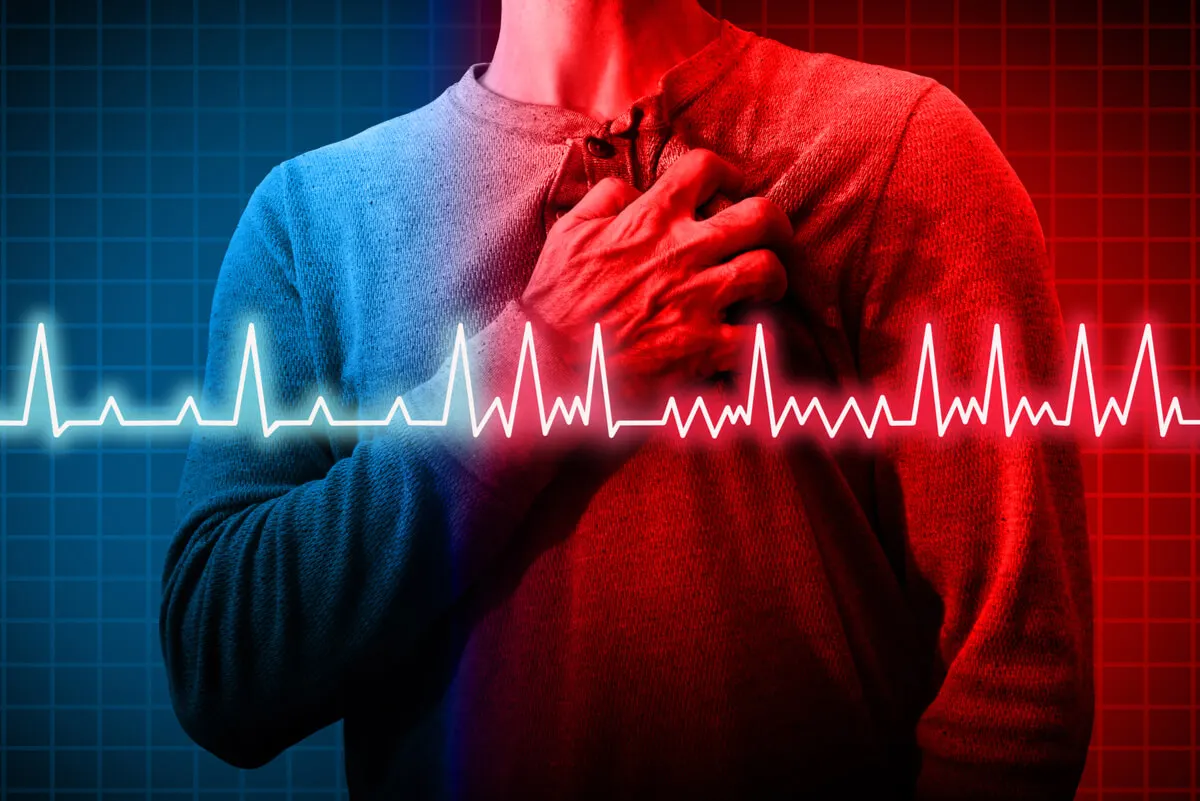Chest Pain On The Right Side: 9 Possible Causes and Treatments


Reviewed and approved by the nurse Leidy Mora Molina
Chest pain is a frequent cause of concern for people. It can range from minor discomfort to a disabling stitch. There are different reasons for chest discomfort, so here are the most common causes of chest pain on the right side.
The chest or thorax is the region of the body located between the neck and the abdomen. It contains the heart, lungs, esophagus, and large vessels, such as the aorta and vena cava. These organs are surrounded by the ribs, thoracic spine, and sternum, as well as the intercostal muscles, pectoral muscles, and back muscles.
The causes of right-sided chest pain range from the involvement of bone and muscle structures to damage to the thoracic organs. Similarly, discomfort may also reflect the involvement of other parts of the body. Here are some of the most common causes.
1. A muscle strain
A muscle strain is one of the most common causes of right-sided chest pain. It usually occurs after a couple of days of intense physical activity at home or in the gym. The discomfort is a result of the breakdown and regeneration of muscle fibers.
The pectoralis major and minor muscles are usually the most affected. The pain is described as a stitching or compression of the chest that improves with rest and intensifies with exercise. In some cases, it’s accompanied by swelling and limitation of arm movement.
This condition usually disappears spontaneously after 1 to 2 days. Professionals recommend rest and massage in the area, as well as the use of analgesic and anti-inflammatory drugs.

We think you may be interested in reading this, too: What to Do When You Experience Chest Pain
2. Direct blows and rib fractures
Trauma to the thorax due to falls or direct blows is a common cause of chest pain on the right side. In the case of traffic accidents, there may be vascular and nerve involvement and even involvement of internal organs.
Moderate to severe blows are accompanied by pain, swelling, and redness of the affected area. Similarly, people may have difficulty moving their limbs and bruises.
It’s advisable to apply cold compresses for 10 to 20 minutes, 2 to 3 times a day, to relieve pain. Nonsteroidal anti-inflammatory drugs (NSAIDs), such as ibuprofen, may be helpful.
In rib fractures caused by impact to the chest, intense pain that limits breathing is common. In addition, it presents with increased sensitivity of the area and swelling. In severe cases, there’s usually pulmonary involvement and it’s accompanied by respiratory difficulty, agitation, and loss of consciousness.
The treatment of fractures is exclusively medical. It’s based on immobilization of the area, repair of the bone defect, and the use of pain medication. Some people require physical therapy.
3. Costochondritis
This is an inflammatory disorder of the chondro-sternal joints, responsible for joining the ribs to the sternum. Studies affirm that this is the most frequent cause of pain in the anterior wall of the thorax, being more common in women, with up to 75% of the cases.
The pain appears at the right or left chest level and extends to the center of the thorax, the back, and the abdomen. It’s usually worse with inspiration and coughing. In addition, palpation of the chondro-sternal joints generates acute and intense pain.
Medical treatment of costochondritis includes rest and the application of physical means, such as hot and cold compresses. Similarly, in acute cases, local infiltration with anesthetics can be performed.
4. Panic attacks
Panic attacks are triggered by episodes of stress or sustained anxiety. This condition usually leads to the appearance of symptoms very similar to those of myocardial infarction. In this regard, it’s common for the person to refer to pain in the center of the chest extending to the right side, jaw, and shoulder.
Other symptoms include the following:
- Tingling and numbness
- Shortness of breath
- Profuse sweating
- Agitation
- Pallor
When a panic attack is suspected, it’s advisable to close your eyes and take deep breaths to calm down. If symptoms persist, seek medical attention as soon as possible.
5. Lung diseases
Lung conditions are a common cause of chest pain on the right and left side. Studies state that it presents as a stabbing in the chest that increases with inspiration, associated with coughing and shortness of breath. Other common symptoms are fever and chills in case of infectious processes.
Pneumonia is usually the most common cause of this type of chest pain. Similarly, this discomfort may occur in the following cases:
- Pleuritis
- Pneumothorax
- Pleural effusion
- Pulmonary embolism
- Lung cancer
Medical treatment depends on the underlying cause. In most cases, a timely approach results in rapid relief of symptoms and a reduced risk of complications.
6. Heart problems
Heart conditions are a very common cause of chest pain. They are common in people of advanced age, obese, and with excessive consumption of cigarettes, coffee, and alcohol.
The pain of cardiac origin manifests as a feeling of tightness in the chest accompanied by palpitations and shortness of breath.
In the case of myocardial infarction. the discomfort occurs on the left side of the chest. However, in women, the pain may appear on the right side of the chest, back, arm, or shoulder. Other symptoms include nausea, vomiting, sweating, and loss of consciousness.
Arrhythmias are another common cause of this discomfort in adults and children. Immediate attention should be sought if either of these two conditions is suspected.

Like this article? You may also like to read: Chest Pain When Coughing: What Are the Causes?
7. Gastroesophageal reflux
This condition is the result of stomach acid rising into the esophagus and irritating the esophagus. Reflux causes a burning, heartburn, or burning sensation inside the chest.
It’s common for the discomfort to intensify after eating. Other associated symptoms are the following:
- Dry cough
- Difficulty swallowing
- A sore throat
- Frequent belching
- A feeling of fullness in the throat and chest
Changes in diet and lifestyle are usually essential to alleviate the condition. In some cases, doctors recommend medications to reduce the acidity and alleviate the symptoms. The gastroenterologist is the specialist to treat this condition.
8. Herpes zoster
This is a condition characterized by a vesicular rash accompanied by intense pain due to reactivation of the varicella-zoster virus. It’s common in adults older than 50 years and in people with decreased immunity.
Onset with pain in the chest and intercostal region, plus the appearance of vesicles with linear arrangement at 48 hours. Skin lesions usually evolve into scabs within 1 week, with definitive healing after 10 to 15 days.
Postherpetic neuralgia is the main complication of this condition. Research states that it manifests with burning or lancinating pain 30 days after the disappearance of the skin lesions.
9. Liver or gallbladder condition
Inflammation of the liver and gallbladder can cause pain on the right side of the chest, due to the proximity of both organs to the chest. The discomfort usually begins on the right side of the abdomen and spreads to the chest.
Some associated symptoms include the following:
- Vomiting
- Dizziness
- Yellow skin
- A loss of appetite
Hepatitis and cholecystitis are some of the most common diseases. If you suspect a liver disease, it’s advisable to consult a gastroenterologist.
Don’t hesitate to seek medical attention
Chest pain on the right side can be caused by a wide variety of situations. Some are simple and require rest and home treatment. However, this symptom could be indicative of serious, life-threatening damage.
It’s best to seek medical attention as soon as possible if the pain is persistent and increases in intensity. Other warning signs include shortness of breath, high fever, confusion, and loss of consciousness.
All cited sources were thoroughly reviewed by our team to ensure their quality, reliability, currency, and validity. The bibliography of this article was considered reliable and of academic or scientific accuracy.
- Hadley, G. R., Gayle, J. A., Ripoll, J., Jones, M. R., Argoff, C. E., Kaye, R. J., & Kaye, A. D. (2016). Post-herpetic Neuralgia: a Review. Current pain and headache reports, 20(3), 17. https://pubmed.ncbi.nlm.nih.gov/26879875/
- Jany, B., & Welte, T. (2019). Pleural Effusion in Adults-Etiology, Diagnosis, and Treatment. Deutsches Arzteblatt international, 116(21), 377–386. https://www.ncbi.nlm.nih.gov/pmc/articles/PMC6647819/
- Vera Rivero, D., Santos Monzón, Y, Gamito González, M, & Aguiar Mota, C. (2019). Características de los pacientes con disección aórtica aguda en Villa Clara: Estudio multicéntrico. CorSalud, 11(2), 97-103. http://scielo.sld.cu/scielo.php?script=sci_arttext&pid=S2078-71702019000200097
- Crespo Marcos, D., Pérez-Lescure Picarzo, F.J., & Zambrano Castaño, M. (2010). Dolor torácico. Pediatría Atención Primaria, 12(45), 95-107. https://scielo.isciii.es/scielo.php?script=sci_arttext&pid=S1139-76322010000100011
- Posada, A., Aguirre, H., Duque, J., & Gil Aldana, V. (2016). Pericarditis constrictiva crónica calcificada idiopática (concretio cordis). CES Medicina, 30(2), 217-224. https://dialnet.unirioja.es/servlet/articulo?codigo=5749334
- Coll Muñoz, Y., Valladares Carvajal, F., & González Rodríguez, C. (2016). Infarto agudo de miocardio. Actualización de la Guía de Práctica Clínica. Revista Finlay, 6(2), 170-190. http://scielo.sld.cu/scielo.php?script=sci_arttext&pid=S2221-24342016000200010
- Reyes Sanamé, F., Pérez Álvarez, M., Alfonso Figueredo, E., Céspedes Cuenca, Y., & Fernández Mendoza, A. (2018). El método clínico aplicado al diagnóstico del dolor torácico agudo. Correo Científico Médico, 22(3), 474-495. http://scielo.sld.cu/scielo.php?pid=S1560-43812018000300011&script=sci_arttext
- Carriquiry, G., & Trostchansky, J. (2020). Manejo actualizado de las fracturas costales. Revista argentina de cirugía, 112(4), 380-387. http://www.scielo.org.ar/scielo.php?script=sci_arttext&pid=S2250-639X2020000400380
- Muñoz, S., Astudillo, C., Miranda,, E., & Albarracin, J. (2018). Lesiones musculares deportivas: Correlación entre anatomía y estudio por imágenes. Revista chilena de radiología, 24(1), 22-33. https://www.scielo.cl/scielo.php?script=sci_arttext&pid=S0717-93082018000100022
- Torres, A., Niederman, M. S., Menéndez, R., Chalmers, J. D., Wunderink, R. G., & Van Der Poll, T. (2021). Pneumonia. Nature Reviews Disease Primers, 7(1). https://www.nature.com/articles/s41572-021-00259-0#citeas
- Sancho, G. P., Zúñiga, V. A., & Corea, S. (2021). Diagnóstico y manejo actualizado del tromboembolismo pulmonar agudo. Revista Médica Sinergia, 6(1), e633. https://revistamedicasinergia.com/index.php/rms/article/view/633
- Thai, A. A., Solomon, B., Sequist, L. V., Gainor, J. F., & Heist, R. S. (2021). Lung cancer. The Lancet, 398(10299), 535-554. https://www.thelancet.com/journals/lancet/article/PIIS0140-6736(21)00312-3/fulltext
- McKnight, C. L. (2023). Pneumothorax. StatPearls. https://www.ncbi.nlm.nih.gov/books/NBK441885/
- Hunter, M. P. (2023). Pleurisy. StatPearls. https://www.ncbi.nlm.nih.gov/books/NBK558958/
- Fazekas, D. (2022). Intercostal Neuralgia. StatPearls. https://www.ncbi.nlm.nih.gov/books/NBK560865/
- Valle, A. (s. f.). Tromboembolismo pulmonar. Fundación Española del Corazón. Consultado el 24 de mayor de 2023. https://fundaciondelcorazon.com/informacion-para-pacientes/enfermedades-cardiovasculares/tromboembolismo-pulmonar.html
This text is provided for informational purposes only and does not replace consultation with a professional. If in doubt, consult your specialist.








